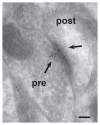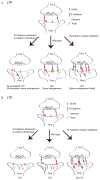Cadherin-based transsynaptic networks in establishing and modifying neural connectivity
- PMID: 25733148
- PMCID: PMC4418560
- DOI: 10.1016/bs.ctdb.2014.11.025
Cadherin-based transsynaptic networks in establishing and modifying neural connectivity
Abstract
It is tacitly understood that cell adhesion molecules (CAMs) are critically important for the development of cells, circuits, and synapses in the brain. What is less clear is what CAMs continue to contribute to brain structure and function after the early period of development. Here, we focus on the cadherin family of CAMs to first briefly recap their multidimensional roles in neural development and then to highlight emerging data showing that with maturity, cadherins become largely dispensible for maintaining neuronal and synaptic structure, instead displaying new and narrower roles at mature synapses where they critically regulate dynamic aspects of synaptic signaling, structural plasticity, and cognitive function. At mature synapses, cadherins are an integral component of multiprotein networks, modifying synaptic signaling, morphology, and plasticity through collaborative interactions with other CAM family members as well as a variety of neurotransmitter receptors, scaffolding proteins, and other effector molecules. Such recognition of the ever-evolving functions of synaptic cadherins may yield insight into the pathophysiology of brain disorders in which cadherins have been implicated and that manifest at different times of life.
Keywords: Cell adhesion molecules; Cognition; LTP; N-Cadherin; Neural development; Protocadherins; Synaptic plasticity.
© 2015 Elsevier Inc. All rights reserved.
Figures


Similar articles
-
The cadherin family of cell adhesion molecules: multiple roles in synaptic plasticity.Neuroscientist. 2002 Jun;8(3):221-33. doi: 10.1177/1073858402008003008. Neuroscientist. 2002. PMID: 12061502 Review.
-
Cadherins and catenins in dendrite and synapse morphogenesis.Cell Adh Migr. 2015;9(3):202-13. doi: 10.4161/19336918.2014.994919. Cell Adh Migr. 2015. PMID: 25914083 Free PMC article. Review.
-
Cadherins and synaptic plasticity.Curr Opin Cell Biol. 2008 Oct;20(5):567-75. doi: 10.1016/j.ceb.2008.06.003. Epub 2008 Jul 19. Curr Opin Cell Biol. 2008. PMID: 18602471 Review.
-
Cadherins and synaptic specificity.J Neurosci Res. 1999 Oct 1;58(1):130-8. J Neurosci Res. 1999. PMID: 10491578 Review.
-
Cell adhesion molecules at the synapse.Front Biosci. 2006 Sep 1;11:2400-19. doi: 10.2741/1978. Front Biosci. 2006. PMID: 16720322 Review.
Cited by
-
Toward discovering a novel family of peptides targeting neuroinflammatory states of brain microglia and astrocytes.J Neurochem. 2024 Oct;168(10):3386-3414. doi: 10.1111/jnc.15840. Epub 2023 Jun 14. J Neurochem. 2024. PMID: 37171455
-
Water-Soluble Lynx1 Upregulates Dendritic Spine Density and Stimulates Astrocytic Network and Signaling.Mol Neurobiol. 2025 May;62(5):5531-5545. doi: 10.1007/s12035-024-04627-1. Epub 2024 Nov 20. Mol Neurobiol. 2025. PMID: 39565568
-
Synaptic promiscuity in brain development.Curr Biol. 2024 Feb 5;34(3):R102-R116. doi: 10.1016/j.cub.2023.12.037. Curr Biol. 2024. PMID: 38320473 Free PMC article. Review.
-
Association of connexin36 with adherens junctions at mixed synapses and distinguishing electrophysiological features of those at mossy fiber terminals in rat ventral hippocampus.Int J Physiol Pathophysiol Pharmacol. 2024 Jun 15;16(3):28-54. doi: 10.62347/RTMH4490. eCollection 2024. Int J Physiol Pathophysiol Pharmacol. 2024. PMID: 39021415 Free PMC article.
-
Neuronal cadherins: The keys that unlock layer-specific astrocyte identity?J Cell Biol. 2023 Nov 6;222(11):e202309050. doi: 10.1083/jcb.202309050. Epub 2023 Oct 19. J Cell Biol. 2023. PMID: 37856080 Free PMC article.
References
-
- Abe K, Chisaka O, Van Roy F, Takeichi M. Stability of dendritic spines and synaptic contacts is controlled by alpha N-catenin. Nature Neuroscience. 2004;7:357–363. - PubMed
-
- Abedin M, King N. The premetazoan ancestry of cadherins. Science. 2008;319:946–948. - PubMed
-
- Al-Amoudi A, Diez DC, Betts MJ, Frangakis AS. The molecular architecture of cadherins in native epidermal desmosomes. Nature. 2007;450:832–837. - PubMed
-
- Anderson TR, Benson DL. Cadherin-mediated adhesion and signaling during vertebrate central synapse formation. In: Dityatev A, El-Husseini A, editors. Molecular mechanisms of synaptogenesis. New York, NY: Springer; 2006. pp. 83–93.
Publication types
MeSH terms
Substances
Grants and funding
LinkOut - more resources
Full Text Sources
Other Literature Sources
Research Materials

